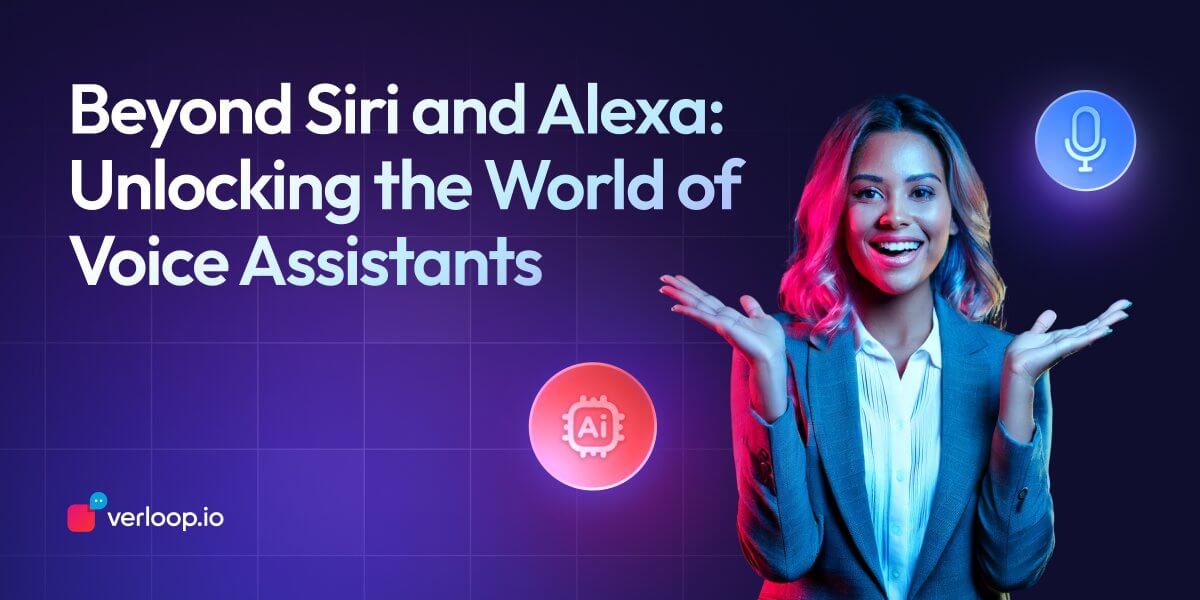What is an AI Chatbot: How it Works, Use Cases, and Industrial Application
- June 16th, 2025 / 11 Mins read
-
Harshitha Raj
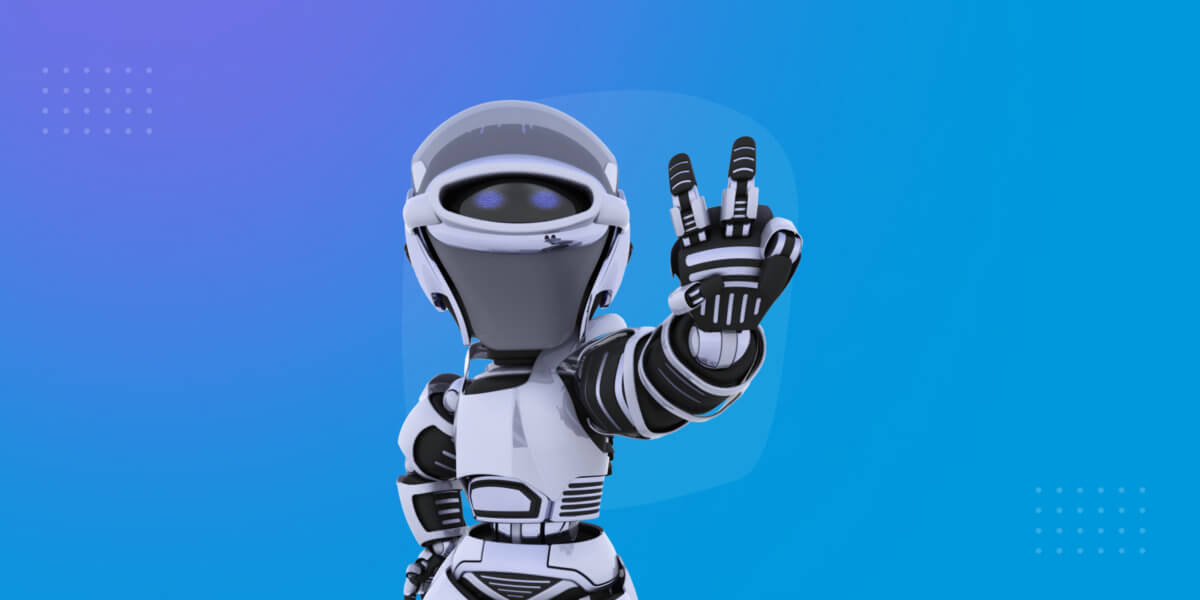
What is an AI Chatbot: How it Works, Use Cases, and Industrial Application
- June 16th, 2025 / 11 Mins read
-
Harshitha Raj
Understanding AI Chatbots
What if your business could hold thousands of conversations—simultaneously, instantly, and round-the-clock?
Sounds like science fiction?
Not anymore.
AI chatbots are making that a reality, and chances are, you’ve already spoken to one. Whether it was tracking an order, booking a ticket, or getting help with a banking query—there’s a good chance a bot, not a human, was on the other side.
But let’s pause for a moment.
- What exactly is an AI chatbot?
- How does it know what to say, or when to escalate to a human?
- And why are so many businesses turning to chatbots to drive support, sales, and even onboarding?
Well, the numbers offer a clue.
The global AI chatbot market is projected to hit $46.6 billion by 2029, growing at a staggering 24.5% CAGR. That’s not hype—it’s adoption in action.
Customers are warming up to them too. 69% say they were satisfied with their most recent chatbot interaction, while 59% expect a reply in under 5 seconds. And as for business hours?
That’s old news!
29% of consumers expect chatbots to be available 24/7.
In this blog, we’ll break down everything you need to know about AI chatbots—what they are, how they work, their real-world use cases, and how different industries are putting them to work.
Let’s dive in.

What is an AI chatbot?
Let’s start with the basics—what exactly is an AI chatbot?
At its core, an AI chatbot is a computer program designed to simulate human conversation. It can understand, process, and respond to user messages in natural language—just like a human would, only faster and more consistently. You’ll find them on websites, mobile apps, messaging platforms like WhatsApp, and even inside voice assistants.
But wait—aren’t all chatbots the same?
Not quite.
There’s a big difference between rule-based chatbots (the old-school kind that only respond to pre-defined scripts) and AI-powered chatbots that use technologies like Natural Language Processing (NLP), Machine Learning (ML), and Large Language Models (LLMs) to understand context, intent, and sentiment.
In simpler terms:
A rule-based bot might only understand “Where’s my order?”
An AI chatbot can interpret:
→ “Hey, I placed an order last week and haven’t received anything yet—can you check on that for me?”
It’s this ability to “read between the lines” that makes AI chatbots far more useful, especially in support, sales, HR, and healthcare settings where conversations aren’t always predictable.
And because they continuously learn from each interaction, their performance improves over time—offering more relevant answers, faster resolution, and ultimately, a better experience for both the user and the business.
How AI Chatbots Work?
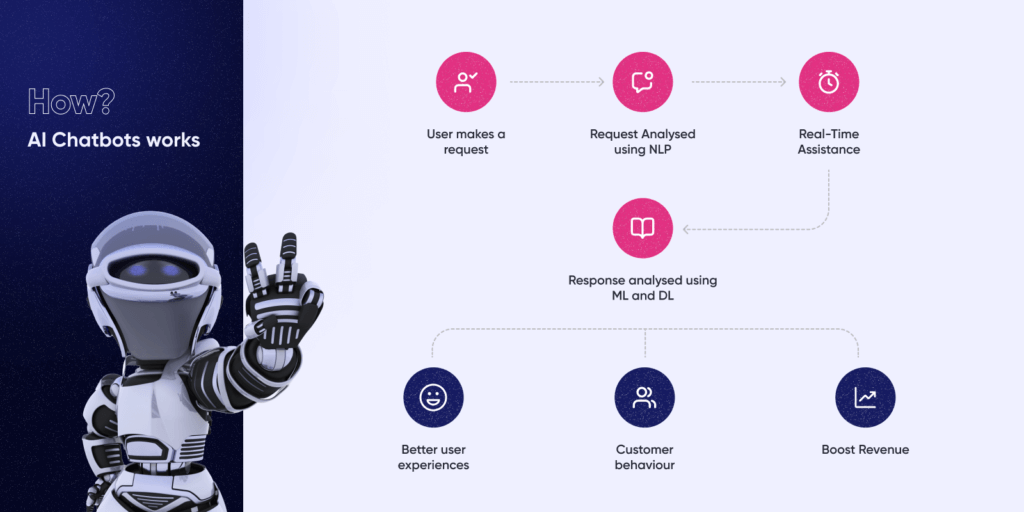
AI chatbots are powered by NLP and ML algorithms to enable them to comprehend and reply to text inputs consistently like humans do. Here’s a general overview of how they work:
- Input Processing: When a user types a message as an input to the chatbot, NLP methods of tokenization, parsing and intent recognition are used to process the text or speech. In this step, the input is split into words or tokens; the grammatical structure is analysed; and the user’s intent is determined (i.e. questions, requests or information provision).
- Context Understanding: Chatbots use dialogue management and context tracking methods to keep track of conversation flow and to contextualise the user’s messages and responses. This enables the chatbot to answer consistently and to provide replies that are relevant to the particular conversation.
- Response generation and delivery: Depending on the purpose, the bot collects entities, gets in contextual conversation and then delivers the response. It may involve the retrieval of stock answers from a database; NLG techniques may be used to dynamically generate replies. The generated response is then formatted and delivered back to the user through the appropriate channel (e.g., text or multimedia).
- Reinforcement learning: Over time and after various interactions, the chatbot will be able to collect the statistics. Each individual chatbot conversation is either a complete success or failure depending on the user. According to this user’s experience, the AI chatbot will reprogram and improve its replies the next time it learns.
The chatbot works with such information as several intents and utterances that are used as the platform for its endless learning. It assists you in programming the bot to offer solutions that meet up with the expectations of the user.
Use Cases of AI Chatbots Across Various Industries
AI chatbots are extensively utilised across diverse industries, each benefiting from their unique capabilities:
1. Banking and financial services
AI chatbots in the banking and financial services industry play a crucial role in enhancing customer experiences and streamlining operations. These chatbots can handle routine customer queries, provide account information, assist with transactions, and offer personalised financial advice based on the user’s profile and preferences.
Maybe you’re thinking about investing some money but aren’t sure where to start. The chatbot can ask you a few questions about your financial goals, risk tolerance, and time horizon, then provide personalised investment recommendations tailored to your needs.
Did you know that 54% of respondents prefer chatbots for making payments? Chatbots can even help protect you from fraud by monitoring your transactions and alerting you to any suspicious activity. If an unauthorised charge appears on your account, the chatbot can quickly flag it and guide you through the process of reporting and resolving the issue.
Read more: How Chatbots in Banking Are Improving Customer Experience
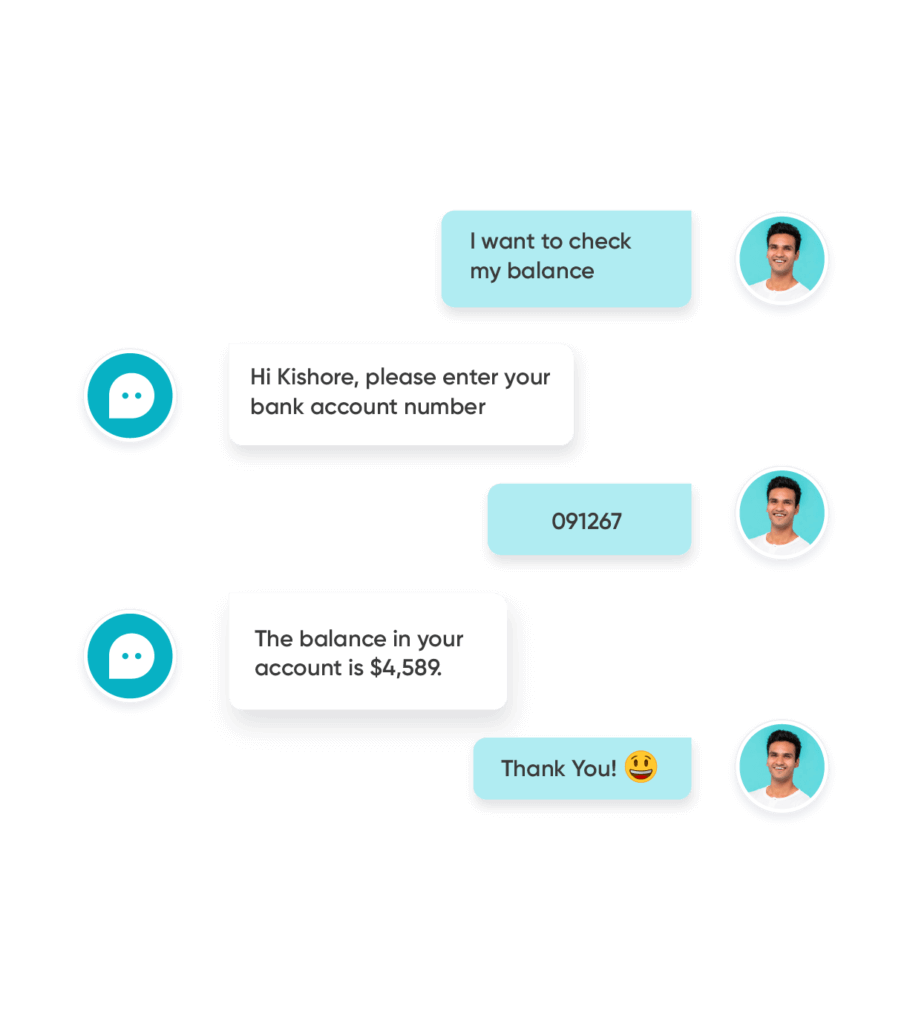
2. Insurance
When we talk about the insurance sector, AI chatbots are the first line of defence when clients request help with their insurance policies. They take care of questions about policy conditions, premiums, and claims process. Through the providing of prompt and reliable answers, chatbots increase customer satisfaction and alleviate the pressure on human agents.
AI chatbots serve as the initial points of contact for clients who may require help in matters related to their insurance. They field inquiries on the policy details, coverage, premiums and claims processes. Through timely and precise response, chatbots help to increase customer satisfaction and decrease the workload on human agents.
Moreover, through the use of machine learning algorithms, AI chatbots use customer data to give personalised insurance tips.
Read more: 10 Use Cases A Chatbot Can Solve For Your Insurance Company.
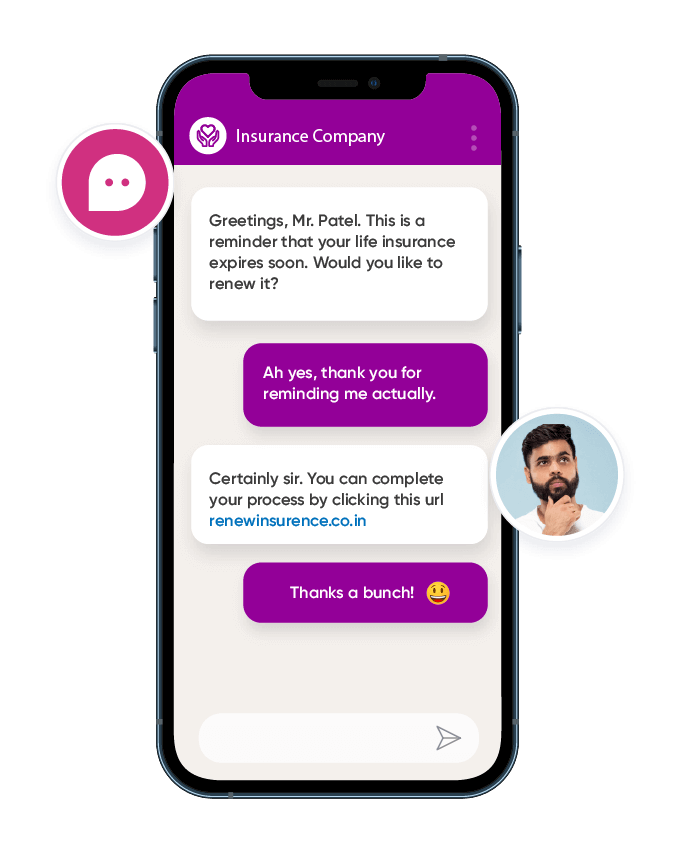
3. eCommerce
We’ve all experienced the frustration of spending hours browsing online stores, only to end up with a cart full of items we’re not quite sure about.
eCommerce businesses that incorporate chatbots in business communication have an open rate of 85% and a click-through rate (CTR) of 40%. McKinsey’s research has shown that AI in e-commerce can achieve a customer retention increase of 10-15% by means of their personalised marketing.
With an AI chatbot, you can get personalised product recommendations based on your preferences, purchase history, and even browsing behaviour.
For example, the chatbot might notice you’ve been looking at a particular brand of hiking boots and suggest some complementary items like hiking socks or trekking poles. It could even offer bundle deals or discounts tailored just for you.
And once you’ve made your purchases, the chatbot can keep you updated on shipping status, let you know when your items have been delivered, and make it easy to initiate returns or exchanges if needed.
Read more: eCommerce Chatbot: 7 Ways To Boost Engagement, Sales, Customer Support
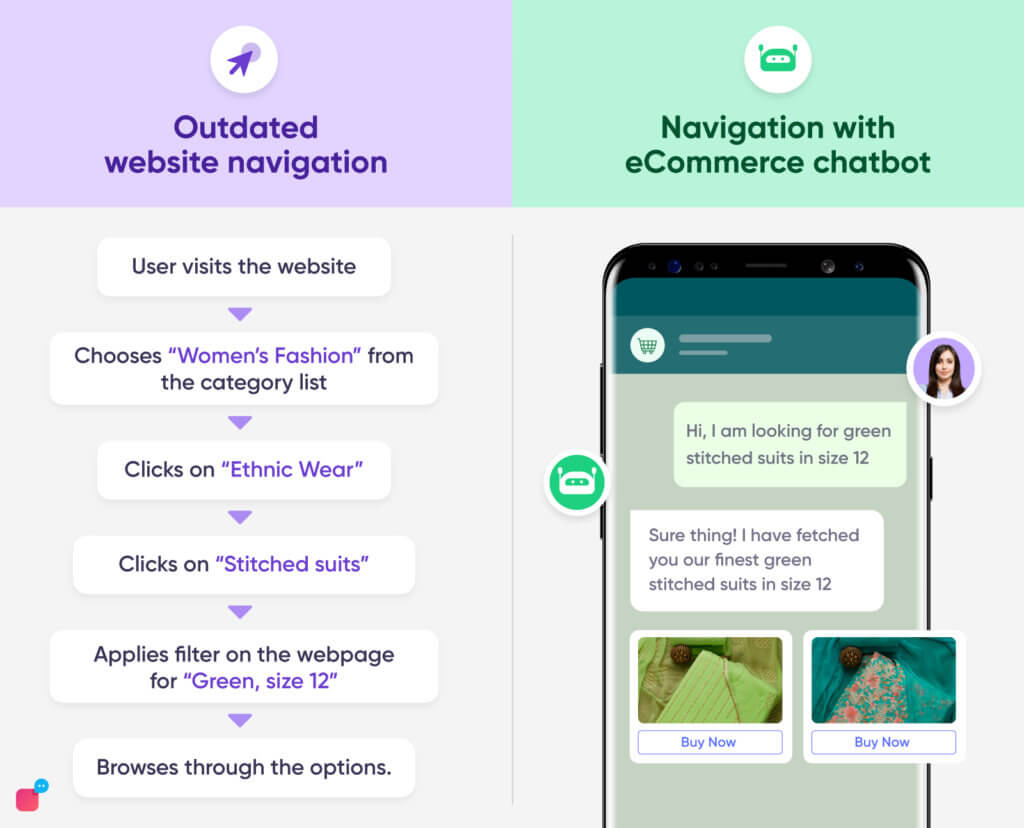
4. Real estate
AI chatbots enable customers to look for homes that fit their tastes by asking them about the location, amount of their budget, size, and amenities that they want. According to the user’s responses, chatbots will help to filter the search and provide listings that meet the criteria, which saves time and effort for property viewing.
Chatbots provide a platform for virtual property tours enabling users to conduct property business from remote locations. AI chatbots can be a powerful tool for lead generation and client nurturing. The bot can respond instantly to inquiries about listings, provide market updates and insights, and automate follow-ups to keep potential clients engaged.
Read more: How To Build Meaningful Customer Relationships With A Real Estate AI?
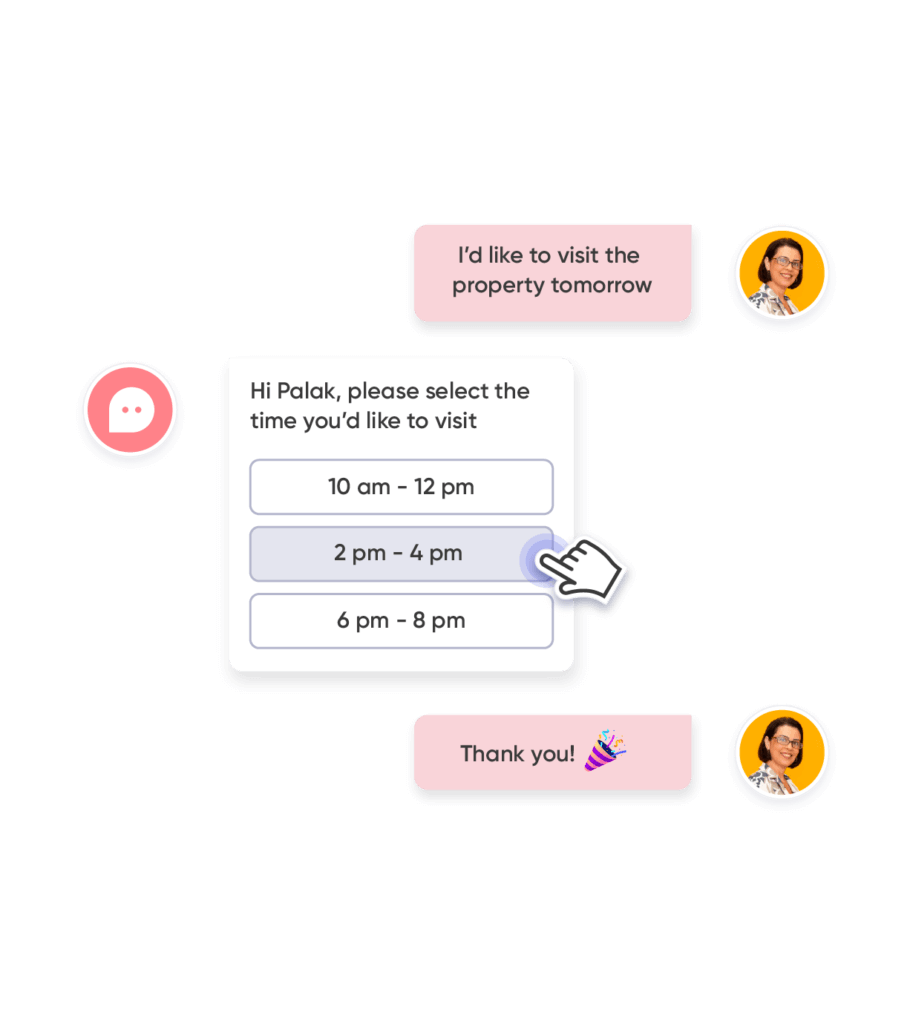
5. Healthcare
The use of AI in the healthcare industry is revolutionising at a fast pace. Specially, as a chatbot, it facilitates the appointment booking process by helping patients book appointments with healthcare providers easily. Patients can set their personal preference for the appointment date, time and type, then the chatbot can check the availability and finalise the booking immediately.
According to Data Bridge Market Research, the global healthcare chatbots market size is to rise from USD 248.93 million in 2022 at a CAGR of 24% and reach USD 1179.81 million by 2030.
AI chatbots undertake preliminary diagnosis of patients by asking pertinent questions about their symptoms, medical history, and the extent of their symptoms. Taking into account the information given, the chatbot can suggest primary medical care, indicate self-help measures or point out what to do next: see a doctor or visit a healthcare professional.
Read more: How to use a medical AI chatbot to stremaline patient care?
6. Ed-tech
We all learn in different ways, and AI chatbots in education can adapt their teaching styles to fit each student’s needs. A chatbot tutoring you in algebra might use visuals and real-world examples for a visual learner, while focusing more on stepwise explanations for someone who prefers a more logical, sequential approach.
These virtual tutors can provide practice problems and give instant feedback, adjusting the difficulty level as you go. 90% of businesses indicate improvements in the complaint handling speed. Thus, these chatbots reduce customer complaints by simulating interactive classroom scenarios to help students build confidence before taking tests or giving presentations.
Read more: 6 Ways Automation is Changing the Edtech Industry
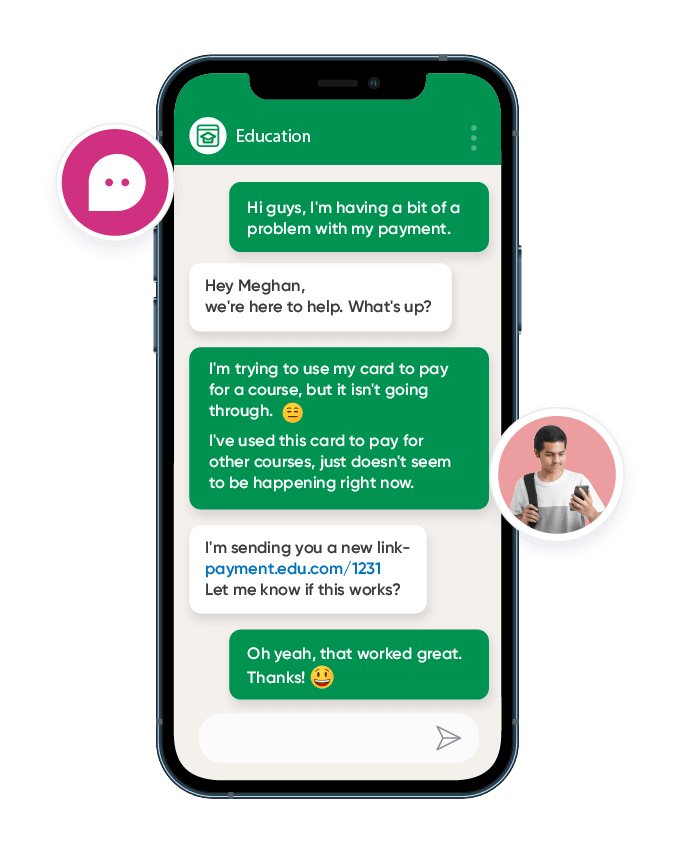
Want to see how AI chatbots are transforming the industries of today? Here are 11 industries using AI automation to grow their businesses.
Benefits of Using AI-Chatbots
Businesses leveraging AI chatbots gain several advantages:
Resolve common queries
Chatbots are excellent in meeting the demands of regularly asked questions and the usual inquiries quickly, round the clock. In 2023, the average queue waiting period was 3 min 40 sec (unlike 5 min 16 sec in 2022). Significant decrease!
Through using NLP and ML models, AI chatbots can understand user queries and give the right and actual responses immediately. Not only does this increase customer service efficiency but also makes for a superior user experience, by giving instant satisfaction.
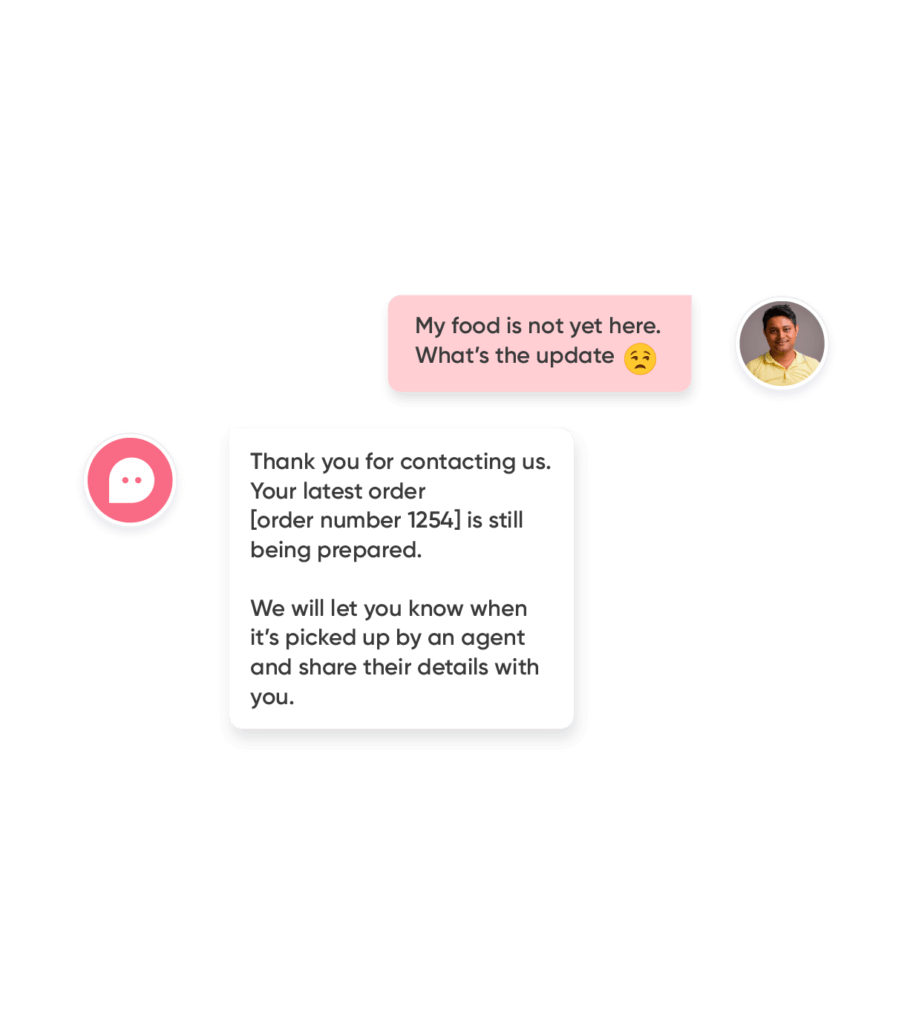
Help users to self-serve
The conversational user interface of chatbots enables customers to self-serve and resolve their problems or queries without requiring human assistance. This is not only the user experience improvement by creating a smooth and convenient way to research but also staff human support teams for more complex issues.
Read more: Customer self-service: Helping users help themselves
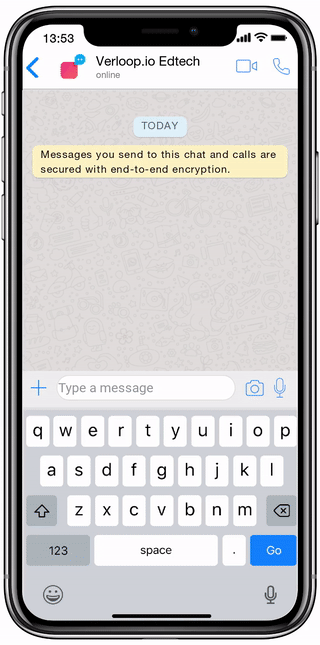
Ensure smart agent routing
Chatbots are able to function as an appropriate triage tool, gathering information pertinent to the user and directing them to the best human agent or department based on their needs.
40% of these customers don’t mind if a chatbot or an agent replies to their query as long as they get it. Though chatbots are doing an outstanding job of handling FAQs, the human agents have to step in for high-end problems. Based on the agent’s competency and skills, the chatbot selects the most suitable candidate onboard to oversee a case.
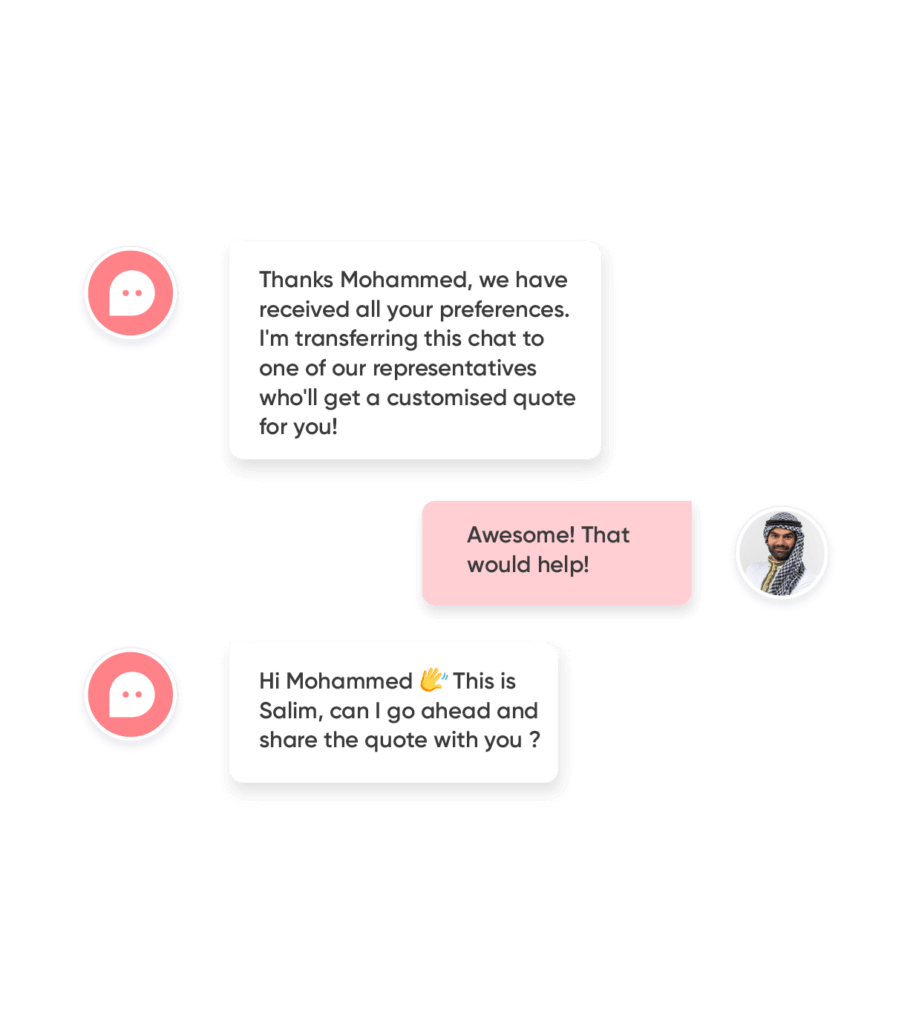
Deliver personalised recommendations
Analysing user data, preferences, and prior interactions, the chatbots can give individualised offers for products, services, or content which are exactly what the user needs and is interested in at the moment.
Such as, the chatbot will suggest the best home loan plan if the user answers questions like his budgetary limit, loan tenure, preferred interest rate and Monthly Instalment as well. This, in turn, improves the user experience and contributes to greater engagement, customer loyalty, and conversions as well.
Read more: 11 ways to automate customer support with personalisation

Collect user data and generate quality leads
The chatbots not only collect valuable consumer data like contact details, likes and dislikes, and interests but also do so during the course of the conversations. This information can be used to gather leads and to optimise advertising campaigns. Well, AI chatbots are capable of increasing conversion rates by 15%.
A strong chatbot can collect and store data in a central place such as a dashboard which can be accessed easily from many different channels. Therefore, whenever the agent needs any context during future activities, they can simply extract user data from the single one-space time accumulated by the AI.
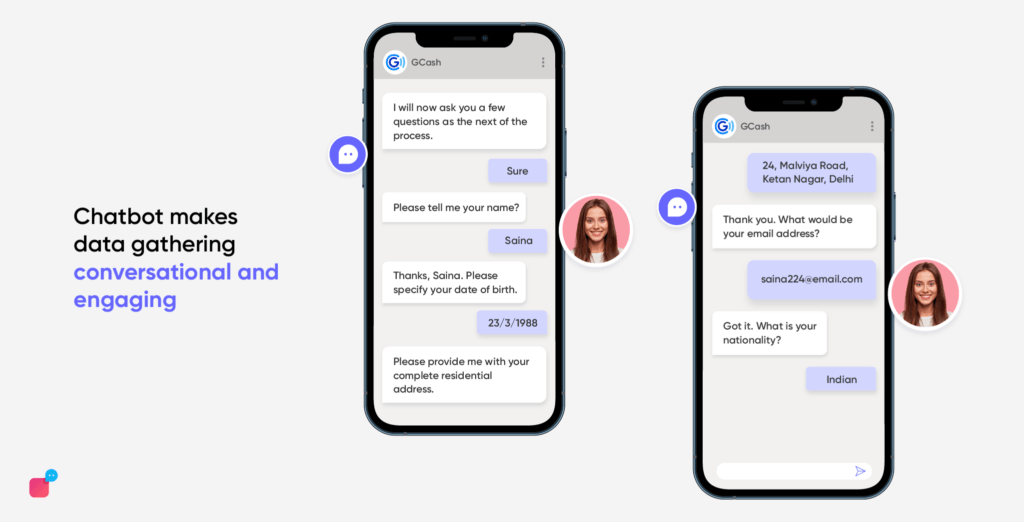
Authenticate and verify user identities
Through its integration with authentication systems, chatbots are able to verify user identities and thus grant safe access to confidential information and services. This not only brings about security, but also creates trust with users, who are becoming more concerned about fraud and data breaches.
Financial institutions such as JPMorgan Chase and Capital One have started deploying chatbots that can authenticate users and offer safe access to account information as well as banking services.
Check out: Conversational Chatbot Security: Threats, Measures, Best Practices
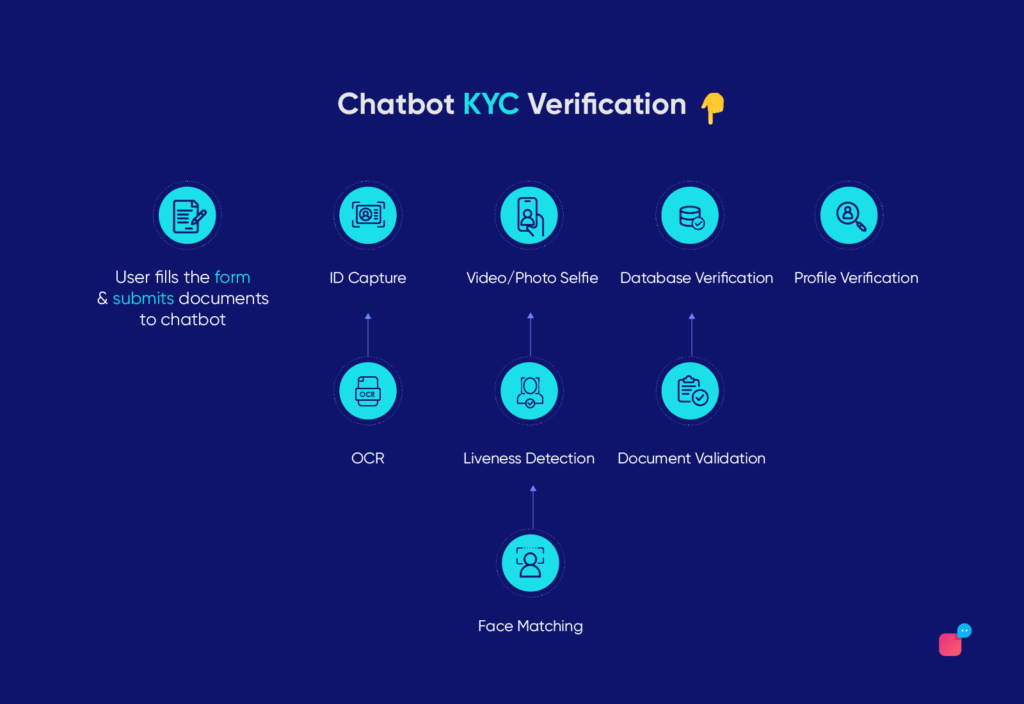
Send reminders and notifications
Chatbots could be programmed to send alerts in a timely manner to users, so they will not miss any significant tasks, appointments or updates. It does not just enhance users’ involvement and satisfaction but can also cause better results within different areas.
Likewise, healthcare providers can employ chatbots for sending medication reminders, appointment confirmations, and preventive care notifications, hence improving patient adherence and ultimately patient outcomes.
Check out: Using Outreach to Proactively Communicating with Your Users
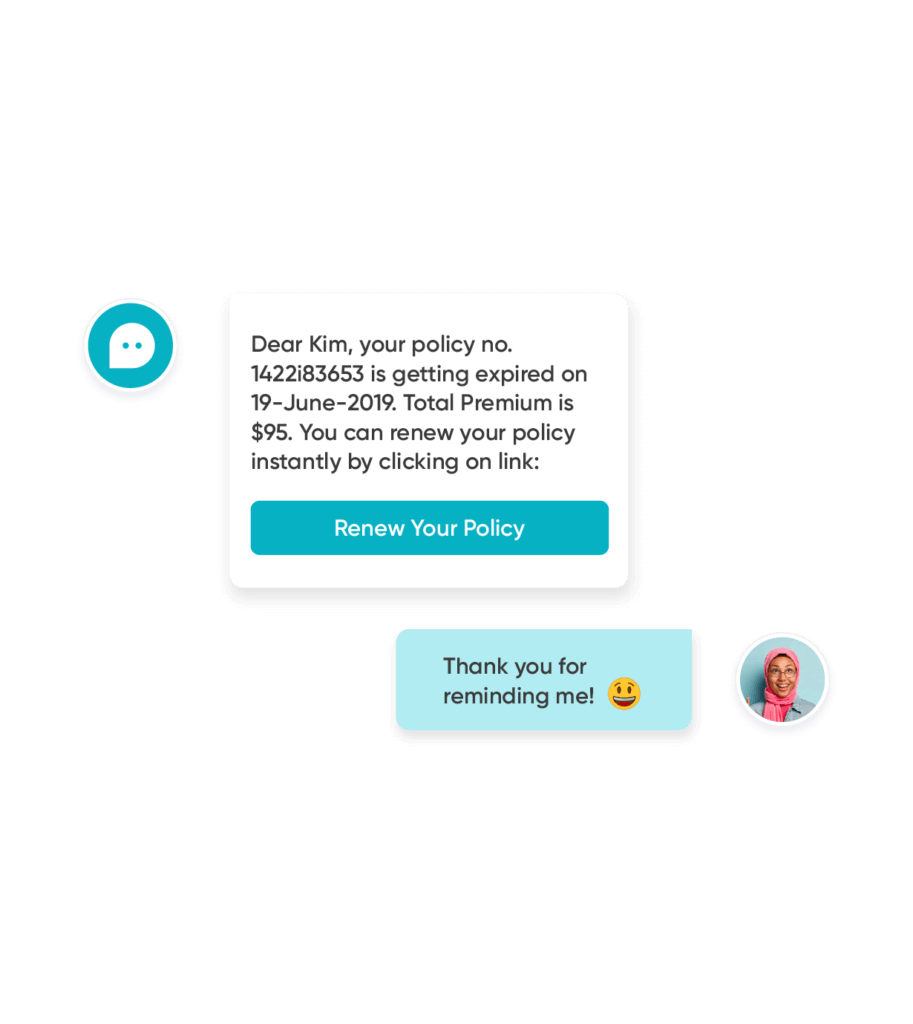
Map user behaviour
With the help of tracking user interactions and conversations, chatbots are able to give crucial clues about customer behaviour habits, interests and issues. With this information service providers can improve their products, services and overall user experiences.
Consequently, the e-commerce chatbots like Amazon’s Alexa and Google Assistant are constantly analysing the user interactions and conversations to get insights into the consumers shopping habits, preferences, and areas of ambiguity or frustration, ultimately helping in the improvement of methods of shopping.
Types of Chatbots
There are three main types of chatbots that businesses can use for their daily customer support and use. They are: rule-based/script-based, AI-based, and hybrid. Here’s an explanation of each type:
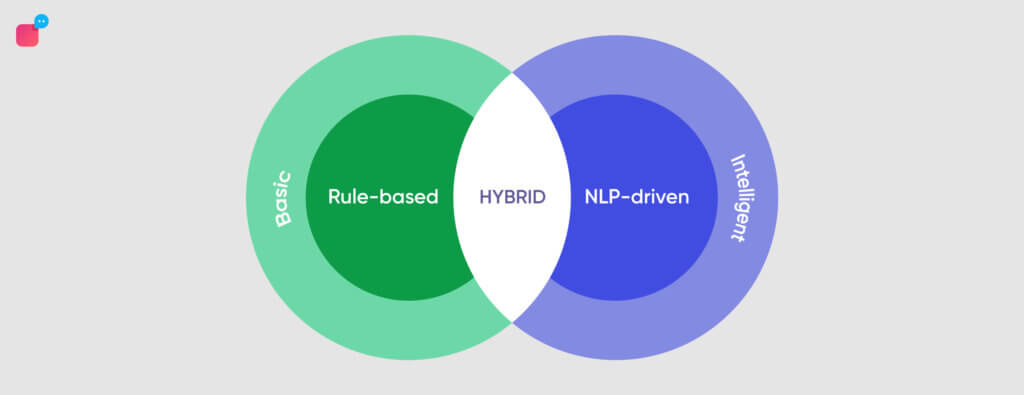
Rule-based/Script-based Chatbots
These chatbots are programmed with pre-defined rules and scripted responses. They follow a decision tree or a flowchart to choose their responses based on some key words or patterns in the client’s input.
Flow: Conversational flow is preset and the chatbot sticks to scripted lines. In case the user enters a particular pattern or a specific keyword, the chatbot gives a predetermined response that goes in line with the searched pattern or keyword.
Approach: Rule-based chatbots leverage pattern matching algorithms and decision trees. They are embedded in a set of rules which define the reaction to particular inputs.
Purpose: Rule-based chatbots are suitable for performance of simple, straightforward tasks such as responding only to a specific domain or a list of scenarios which are predetermined. They are very frequently used for customer support, FAQs, and simple queries.
AI-based Chatbots
AI- chatbots powered rely on NLP, ML, and other advanced technology algorithms to comprehend and respond to the human language. They can get involved in contextual and less goal-directed dialogues.
Flow: The conversation format is alive and flexible. The AI-based chatbots have the ability to understand the meaning and purpose of the input of the user and respond properly depending on the context.
Approach: AI-powered chatbots employ NLU, dialogue management, and NLG to understand and respond to user inputs using a natural language. They can learn from previous conversations and they can evolve over time.
Purpose: AI-based chatbots are great for jobs that are more complicated than simple exchanges by using natural language processing, context, and individualised responses. They are humanised for customer service, virtual assistants, and intelligent conversational agents.
Hybrid Chatbots
The hybrid chatbots are the combination of two rule-based and AI-based methods. They rely on predefined rules and scripts for simple tasks while AI technology is used for more complex communications.
Flow: In this case, the conversation flow can switch to scripted responses and the real-time AI-generated responses, based on the complexity of the user’s input and the chatbot’s capabilities.
Approach: Hybrid chatbots unite rule-based systems with AI-enabled components like NLP and ML models. They can handle simple queries with canned responses and utilise AI for more complex conversations.
Purpose: The goal of hybrid chatbots is to provide the best of both directed and AI-based systems worlds by combining reliability and efficiency of rule-based systems with the adaptability and intelligence of AI based systems. They fit the situations where simple and complex dialogues are appropriate, so users enjoy a smooth journey through the conversation.
Note: What must be kept in mind is that the type of chat bot chosen is dependent on the specific use case, the level of complexity of the tasks, and the resources available. Rule-based chatbots are usually simpler to build and to maintain, but they have only limited capabilities, while AI-based chatbots, which are more advanced, demand more resources and training data. Hybrid chatbots ensure that the strong points of each of these two approaches is used while their shortcomings are minimised.
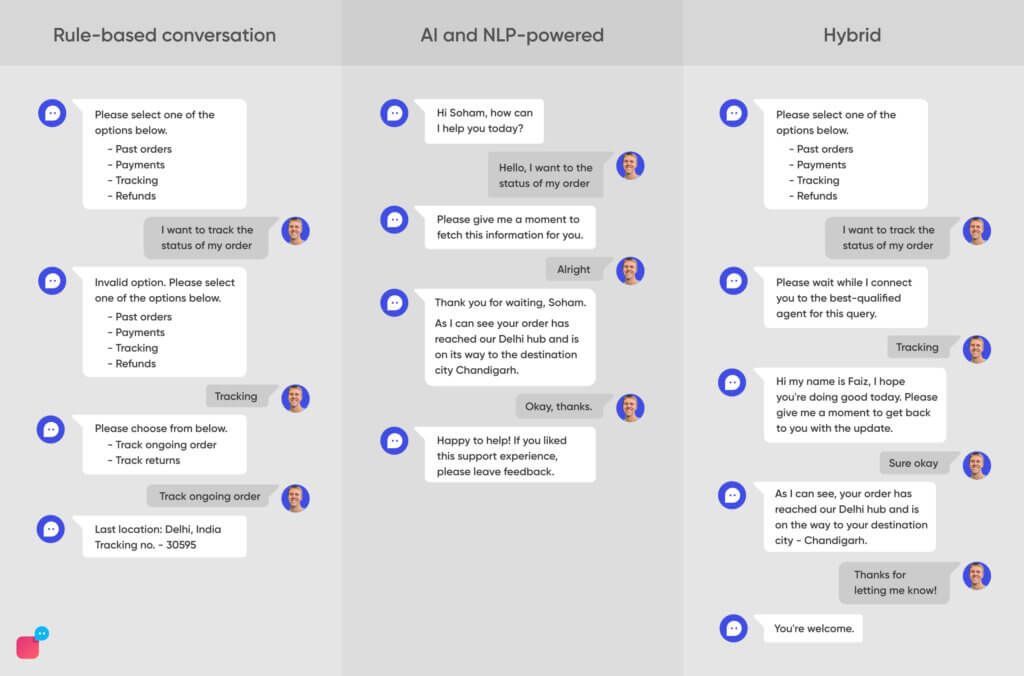
| Factors | Rule-based/script-based | AI | Hybrid |
| Functionality | Transactional | Conversational | Transactional + Conversational |
| Flow | Menu-driven, one-way | Bidirectional | Bidirectional |
| Approach | Encoded rules, if-then-else statements | NLP/NLU, ML, NLG | Encoded rules, NLP/NLU, ML, NLG, smart agent routing |
| Purpose | Process navigation | Out-of-the-box assistance in natural language | Defined use-case navigation, capable of assisting based on the type of query |
Future Trends of AI Chatbot
Creating effective AI chatbots necessitates several key factors:
Clear Goals and Target Audience
Creating an effective chatbot involves setting clear goals and recognizing the target audience. Organisations are focusing more on integrating chatbot functionalities that suit their precise business objectives, be it improving customers’ experience, removing bottlenecks in internal processes or serving recommendations.
Simultaneously, they are grasping an in-depth understanding of the target users’ needs, preferences, and communication styles. Through the customisation of chatbots to specific industries, use cases, and demographic groups, organisations can develop more exciting and fruitful conversion experiences.
High-Quality Training Data
The quality and diversity of the training data are the two main factors that determine the accuracy and relevance of the responses of the chatbot. Organisations are spending huge money containing high-quality datasets including conversational logs, domain specific knowledge bases and multilingual data.
Different methods such as data augmentation, transfer learning, and few-shot learning are being investigated to optimally utilise the limited training data. Continuous growth and adjustment of training datasets by organisations will assure better performance of chatbots. This in turn will make conversations more smooth and context-sensitive.
Continuous Testing and Improvement
Chatbot design is an iterative process, and organisations are understanding the importance of constant testing and improvement. They use agile development procedures, user input, and carry out evaluations to check the performance and find areas for improvement.
Technologies like online learning, reinforcement learning, and human-in-the-loop training are being investigated to allow chatbots to learn and adapt endlessly from the situations they experience in the real world. This constant optimization means that chatbots stay current, correct, and provide services that are in line with the changing expectations of the users.
User Privacy and Ethical Considerations
Since chatbots interact with highly sensitive user information and interact with users on a personal level, data protection and ethical issues have emerged as a critical aspect. Organisations will be attempting to comply with data privacy regulations like GDPR and CCPA, as well as implementing strong data security procedures for the user data protection.
Furthermore, they ensure ethical norms, like transparency, fairness, and accountability, during the development of chatbots. Through their compliance with these regulations, organisations have an opportunity to develop trust with their users and promote the responsible use of AI.
Multimodal Interactions
Chatbots are extending beyond text-based interactions providing multimodal support where there is a combination of text, voice, images and other modalities. This trend is fueled by chatbots integration with virtual assistants, smart speakers, and conversation AI platforms which in turn provision smooth interactions across devices and channels.
Besides that, computer vision and natural language processing technologies are being combined to make chatbots understand and respond to visual inputs, such as images and videos. Multimodal interactions enrich the experience and make chatbot conversations that mimic natural interactions.
Furthermore, upcoming advancements in AI chatbots are anticipated to include more advanced Natural Language Processing (NLP) and sentiment analysis. Additionally, there will be further integration with AI voice assistants across multiple channels, and chat experiences will become increasingly personalised based on user history and preferences.
FAQs
1. Are AI chatbots effective?
AI chatbots are highly effective in deflecting up to 80% of all user queries. Since most of these queries are repetitive, AI chatbots can be trained to resolve most of them autonomously. They are effective in reducing the work overload on human agents, and lowering costs, while digitally transforming a business with smart automation. The effectiveness (accuracy) depends on how well the AI is trained and the ML models used.
2. What AI techniques are used in chatbots?
AI chatbots are equipped with natural language processing (NLP), machine learning, and cognitive computing are some of the top techniques used to make an AI chatbot smart, conversational, interactive, and accurate with its responses.
3. What are some examples of chatbots?
We have worked on a list of top chatbots that deliver exceptional user experiences, check it out here: 10 Best Chatbot Examples For Better Customer Service
3. What are some disadvantages of chatbots?
While chatbots are developed to augment digital interactions, there can be a few downsides to a poorly built chatbot. Some of them include inaccurate input analysis that leads to irrelevant outputs, the ability to respond with only limited options, poor security infrastructure, robotic speech, inability to understand human emotion and tones. However, training your chatbot well can avoid most of these issues. Read more: 5 Easy Ways to Train a Chatbot
4. Why are chatbots the future?
Almost every business has gone digital today. The shift has been largely because users want to connect conveniently, interact, buy, and seek support on digital channels. Attending users at such a scale (and doing so manually) would inadvertently dampen the speed and efficiency of end-to-end conversations. Chatbots are making this a lot simpler for brands and their users. AI chatbots are trained to talk to customers and perform specific use cases for the business around the clock in real time. They drastically reduce delays in customer communication and streamline interactions as businesses scale up. Here’s how you can future-proof your business with AI.
Conclusion
AI chatbots have truly changed communication for companies that want to build for the future. Digital consumerism will only grow in the coming years, which means businesses need to be in tandem with their users to thrive. Manning an exclusively human team to deliver diligent, on-time, and individual attention to users is not wise gameplay. This is exactly where an AI chatbot can help your business build solid customer relationships that stem from unwavering customer support.
Verloop.io is on a mission to make this a reality for businesses worldwide! Our conversational AI serves as complete customer support operating system built for teams that believe the road to success is through happy customers. Schedule a demo with one of our conversational experts today to get started.






